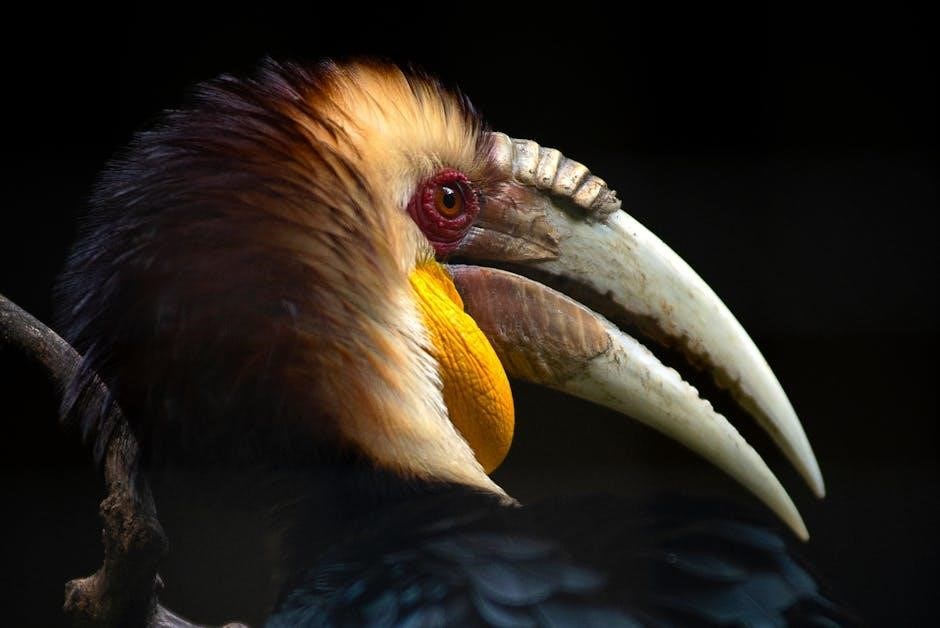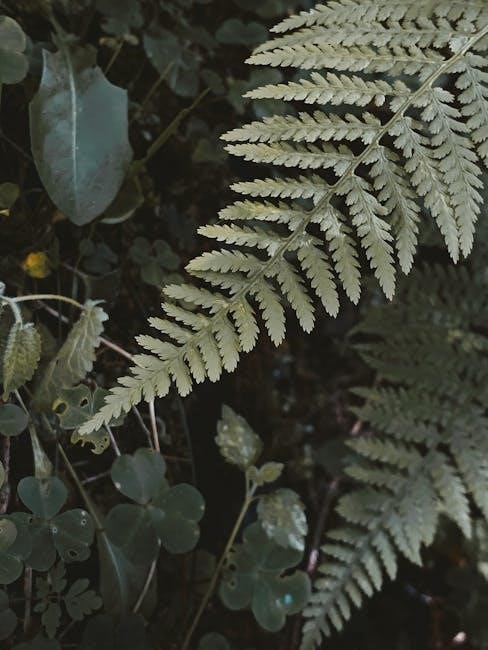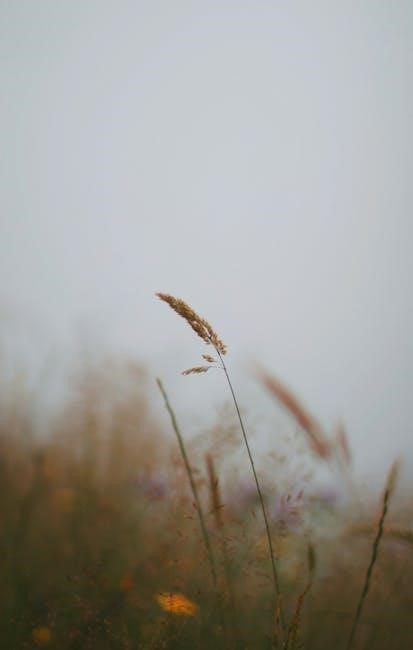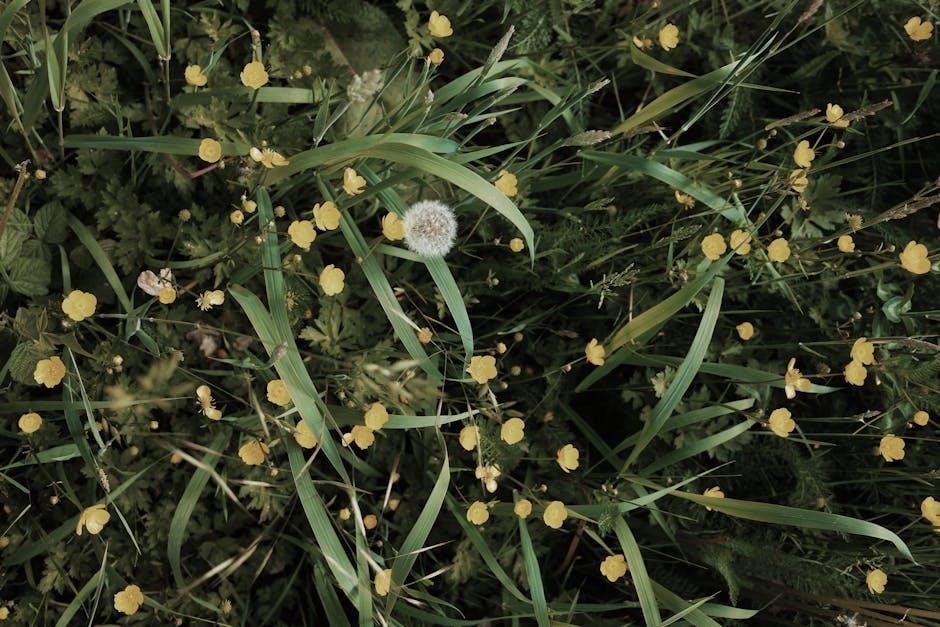Identifying weeds is crucial for effective garden management and biodiversity preservation․ Photography plays a key role in weed identification, offering visual insights that help distinguish species․ This guide provides a detailed list of common garden weeds, supported by images, to aid enthusiasts in recognizing and managing unwanted plants effectively․

1․1 Importance of Identifying Weeds
Identifying weeds is essential for maintaining healthy gardens and ecosystems․ Weeds compete with desired plants for water, nutrients, and light, potentially harming their growth․ Some weeds, like Japanese knotweed, are highly invasive and can damage infrastructure or spread rapidly․ Accurate identification ensures targeted management, preventing unnecessary harm to beneficial plants․ Additionally, certain weeds, such as dandelions or nettles, have ecological value or practical uses, making proper recognition crucial․ Photography serves as a reliable tool for distinguishing species, especially for novices․ By understanding the characteristics of weeds, gardeners can adopt effective strategies to control their spread and protect biodiversity․ Timely identification also helps prevent infestations from becoming unmanageable, reducing the need for herbicides and promoting sustainable gardening practices․ In summary, recognizing weeds is vital for balancing garden health, preserving the environment, and optimizing weed control methods․
1․2 Role of Photography in Weed Identification
Photography is a powerful tool in weed identification, providing clear visual references for accurate recognition․ High-quality images capture essential details such as leaf shapes, flower structures, and growth patterns, which are critical for distinguishing species․ For instance, the distinctive yellow flowers of dandelions or the lobed leaves of plantain can be easily identified through photos․ This visual aid is particularly valuable for gardeners and botanists, enabling them to diagnose weeds without physical samples․ Online platforms and PDF guides now offer extensive databases of weed images, making identification more accessible․ Photography also fosters education and awareness, helping users understand the characteristics of invasive species like Japanese knotweed․ By leveraging photography, individuals can make informed decisions about weed management, ensuring effective control and minimizing environmental impact․ This method bridges the gap between technical knowledge and practical application, making weed identification user-friendly and efficient․

Common Weeds Found in Gardens
Common garden weeds like Japanese Knotweed, Dandelion, Nettle, Plantain, Dock, Thistle, Chickweed, and Clover are widespread․ This guide provides photos and descriptions to aid in their identification and effective management․
2․1 Japanese Knotweed (Fallopia japonica)
Japanese Knotweed, or Fallopia japonica, is one of the most invasive and destructive weeds worldwide․ Recognizable by its bamboo-like stems and heart-shaped leaves, it grows rapidly, forming dense stands that overshadow native plants․ Its ability to spread through underground rhizomes makes it challenging to control, often leading to significant ecological and economic damage․ Photos in this guide highlight its key features, such as its reddish nodes and flat, oval-shaped leaves․ Early identification is critical, as mature plants can penetrate foundations and disrupt ecosystems․ Eradicating Japanese Knotweed typically requires a combination of physical removal and herbicide treatment, often necessitating professional intervention․ This guide provides visual aids and management tips to help gardeners and landowners combat this notorious weed effectively․
2․2 Dandelion (Taraxacum officinale)
The Dandelion, scientifically known as Taraxacum officinale, is one of the most recognizable and widespread weeds found in gardens and lawns․ It is easily identifiable by its bright yellow, cluster-like flowers and distinctive, feathery leaves that grow in a rosette pattern․ The plant is notorious for its ability to disperse seeds through its characteristic puffball, which can carry seeds over long distances, leading to rapid colonization of areas․ Dandelions thrive in various soil types and are often considered invasive due to their aggressive growth habits․ This guide includes high-quality images of the Dandelion at different growth stages, showcasing its key features, such as its jagged, toothed leaves and tall, hollow stems․ Photos also highlight the plant’s life cycle, from flowering to seed dispersal․ Understanding its appearance and growth patterns is essential for effective management, as Dandelions can outcompete desired plants for nutrients and space․ Regular removal, either manually or through herbicides, is often necessary to control its spread and maintain garden health․
2․3 Nettle (Urtica dioica)
The Nettle, scientifically known as Urtica dioica, is a common and persistent weed found in gardens, meadows, and waste areas․ Recognizable by its heart-shaped, serrated leaves and fine, stinging hairs that cause skin irritation, the Nettle is a perennial plant that grows up to 1․5 meters tall․ It thrives in rich, fertile soils and can form dense patches, competing with desired plants for nutrients․ The plant produces small, greenish flowers in summer, which are followed by seed production, aiding its spread․ This guide includes detailed images of the Nettle, showcasing its leaves, stems, and flowers, as well as its characteristic stinging hairs․ Photos also highlight its growth habits, such as its ability to form clumps and spread through underground rhizomes․ Understanding the Nettle’s life cycle and identification features is crucial for effective management, as it can be challenging to eradicate due to its deep root system․ Regular physical removal or targeted herbicides are often necessary to control its proliferation in gardens․
2․4 Plantain (Plantago lanceolata)
Plantain (Plantago lanceolata) is a common perennial weed found in gardens, lawns, and disturbed areas․ It is easily identifiable by its narrow, elongated leaves that grow in a rosette pattern at the base of the plant․ The leaves are typically bright green, lance-shaped, and have prominent veins․ Plantain produces tall, erect flowering stems that can reach up to 30 cm in height, topped with dense, spike-like seedheads․ These seeds are a key method of propagation, allowing the plant to spread quickly in fertile soils․ Often considered invasive, Plantain competes with desirable plants for nutrients and water․ Photos in this guide highlight the plant’s distinctive foliage, flowering stems, and seedheads, aiding in accurate identification․ Management strategies often involve regular removal of seedheads to prevent propagation and physical or chemical control methods to eradicate established plants․ Proper lawn care practices, such as maintaining dense grass cover, can also help suppress its growth․
2․5 Dock (Rumex obtusifolius)
Dock (Rumex obtusifolius) is a widespread perennial weed often found in gardens, meadows, and disturbed soil․ It is characterized by its broad, oval-shaped leaves with a rounded base and wavy margins․ The leaves are typically dark green and can grow up to 20 cm in length․ Dock produces a tall, erect flowering stem that can reach heights of 1 meter, bearing dense clusters of small, greenish flowers that mature into winged seed pods․ The plant’s red-tinged stems and veins are distinctive features․ Dock thrives in nutrient-rich soils and can propagate both by seed and through a deep taproot, making it challenging to eradicate․ Photos in this guide showcase the plant’s foliage, flowering spikes, and seed pods, aiding in accurate identification․ Regular removal of seed heads and persistent control measures are essential to manage its spread․ This weed is often considered invasive due to its ability to outcompete native vegetation and grow in a variety of conditions․
2․6 Thistle (Cirsium arvense)
Thistle (Cirsium arvense), also known as Canada thistle, is a highly invasive, perennial weed common in gardens, meadows, and agricultural fields․ It is recognizable by its prickly, deeply lobed leaves with sharp spines, typically green on the upper surface and woolly below․ The plant grows from a network of underground rhizomes, allowing it to spread rapidly and form dense colonies․ Thistle produces vibrant purple flowers in mid-summer, clustered at the ends of branched stems that can reach up to 1․5 meters in height․ These flowers attract pollinators but also contribute to the plant’s prolific seed production․ Images in this guide highlight the plant’s distinctive foliage, flowering clusters, and growth habits․ Control methods often involve repeated mowing to prevent seed formation and targeted herbicide application․ Thistle’s ability to regenerate from root fragments makes manual removal ineffective unless all root material is removed․ This weed poses significant challenges to gardeners and farmers alike due to its resilience and rapid spread․
2․7 Chickweed (Stellaria media)
Chickweed (Stellaria media) is a common, fast-spreading annual or biennial weed found in gardens, lawns, and waste areas․ It is characterized by its small, oval-shaped leaves with a pointed tip, typically arranged oppositely along slender stems․ The leaves are smooth and pale green, while the stems often have a line of fine hairs along their length․ Chickweed grows in a variety of conditions, thriving in moist, fertile soils, and can form dense mats that choke out desirable plants․
The plant produces small, white, star-shaped flowers in clusters at the end of its stems, blooming from spring through autumn․ These flowers are followed by seed pods that split open to release numerous small seeds, which can germinate quickly․ Chickweed is also edible and is sometimes used in salads or herbal remedies, though its invasive nature makes it a nuisance in gardens․
Control methods include hand-pulling for small infestations, mowing to prevent seeding, and applying mulch to suppress seedlings․ Persistent management is essential, as chickweed can regrow from leftover stems and seeds․ Regular lawn maintenance and improving soil health can help prevent its spread․
2․8 Clover (Trifolium repens)
Clover (Trifolium repens) is a perennial weed commonly found in lawns, meadows, and along roadsides․ It is recognized by its distinctive trifoliate leaves, with three leaflets that are typically green and oval-shaped․ Clover often grows close to the ground, forming a dense mat, and spreads through creeping stems that root at the nodes․ The plant produces small, rounded flower heads that are pink or white, which are attractive to pollinators․
Clover thrives in poor soil conditions and can outcompete grass and other plants, making it a nuisance in well-manicured lawns․ However, it is also valued for its ability to fix nitrogen in the soil, improving soil fertility․ While some gardeners consider it a weed, others intentionally cultivate it as a beneficial ground cover․

Control methods for clover include regular mowing, improving soil quality to promote competing plants, and applying targeted herbicides․ Despite its invasive nature, clover is a versatile plant with both ecological and practical uses․ Its ability to thrive in various conditions makes it a common sight in many landscapes․
How to Use the PDF Guide
This comprehensive PDF guide provides detailed descriptions and high-quality images of common weeds, enabling easy identification․ Navigate through categorized sections, use the index for quick access, and refer to management tips for effective weed control in your garden․
3․1 Navigating the Guide
This PDF guide is designed to be user-friendly, with a clear structure that allows gardeners to quickly locate information․ The guide is organized alphabetically by common weed names, making it easy to find specific plants․ Each entry includes a high-quality image, scientific name, and key characteristics for accurate identification․
Visual aids, such as comparison charts and lifecycle diagrams, help users understand growth patterns and distinguish similar species․ The guide also features a detailed index, enabling rapid access to specific weeds․ Additionally, interactive elements like hyperlinks and QR codes provide further resources, such as management tips and ecological insights․

Users can navigate seamlessly through sections dedicated to prevention, physical removal, and ecological impact․ Whether you’re a novice or an experienced gardener, this guide offers a straightforward approach to identifying and managing weeds effectively․ Its intuitive layout ensures that you can focus on solving weed-related challenges without unnecessary complexity․
3․2 Understanding the Layout
The PDF guide is meticulously organized to ensure clarity and ease of use․ Each weed species is presented on a dedicated page, with a clean layout that prioritizes readability․ The top section of each page displays the weed’s common name, scientific name, and family, providing immediate identification․

High-resolution images are prominently featured, showcasing key characteristics such as leaves, flowers, and growth habits․ These visuals are accompanied by concise descriptions, highlighting distinctive features and potential look-alikes․ Icons and color-coded sections differentiate prevention tips, removal methods, and ecological notes, making the information easily scannable․
The guide also incorporates visual hierarchies, such as bold headings and bullet points, to break down complex information․ Captions under images provide context, while sidebars offer quick access to essential management strategies․ This thoughtful design ensures users can quickly locate and understand the information they need to effectively manage weeds in their gardens․

Tips for Effective Weed Management
Effective weed management combines monitoring, cultural practices, and targeted interventions․ Regularly inspect your garden, use mulching to suppress growth, and maintain soil health to prevent weed dominance․ Judicious herbicide use and manual removal are also essential for long-term control․
4․1 Prevention Methods
Preventing weeds from taking root is often more effective than removing them after they grow․ One key method is improving soil health through composting and mulching, which creates an environment where desired plants thrive and weeds struggle to compete․ Cover crops can also suppress weed growth by occupying space and blocking light․ Regularly monitoring your garden and removing weeds before they seed is another essential strategy․ Using physical barriers, such as landscaping fabric, can prevent weeds from germinating in specific areas․ Additionally, maintaining dense plantings ensures that weeds have limited space to establish themselves․ Lastly, educating yourself about the common weeds in your region, using resources like the liste des mauvaises herbes avec photo PDF, helps in early identification and prevention․ By combining these methods, you can significantly reduce weed infestations and protect your garden’s ecosystem․
4․2 Physical Removal Techniques

Physical removal is a straightforward and effective method for controlling weeds, especially when chemical use is minimized․ Hand-pulling is ideal for small infestations, ensuring the entire root system is removed to prevent regrowth․ For larger areas, tools like hoes or cultivators can efficiently cut weeds at the soil surface, disrupting their growth․ Using a weeding fork is particularly effective for tap-rooted weeds, such as dandelions, allowing deep removal without breaking the root․ Timing is crucial; removing weeds when they are young and before flowering prevents seed dispersal․ Regular maintenance and consistent effort are key to long-term success․ Additionally, employing thermal weeders or flame guns can kill weeds without chemicals, targeting them at vulnerable stages․ Physical methods may require more labor but offer an eco-friendly solution to weed management, preserving soil health and biodiversity while maintaining garden aesthetics․
Ecological Impact of Weeds
Weeds can outcompete native plants, reduce biodiversity, and disrupt ecosystems․ However, some species provide benefits, such as food for pollinators or soil stabilization․ Understanding their ecological role is essential for balanced management strategies․

5․1 Benefits of Certain Weeds
While often viewed as pests, certain weeds offer ecological benefits․ For instance, dandelions provide essential pollen for pollinators like bees, supporting biodiversity․ Plantain and chickweed have medicinal properties, used in natural remedies․ Additionally, some weeds act as natural fertilizers, enriching soil health․ Their role in stabilizing soil and preventing erosion is also significant․ Moreover, weeds like clover fix nitrogen, improving soil fertility for other plants․ Recognizing these benefits encourages a balanced approach to weed management, where selective removal preserves ecological harmony․ By understanding their positive contributions, gardeners can make informed decisions about which weeds to control and which to tolerate, fostering a sustainable environment․

5․2 Environmental Concerns
Certain weeds pose significant environmental risks, particularly invasive species like Japanese Knotweed, which can damage infrastructure and outcompete native vegetation․ These plants often spread rapidly, disrupting local ecosystems and reducing biodiversity․ For example, Dandelion and Plantain can quickly colonize areas, pushing out indigenous species․ Additionally, some weeds harbor pests or diseases that harm crops and wildlife․ Their ability to adapt to various conditions makes them challenging to control․ Invasive weeds also contribute to soil erosion and alter nutrient cycles, further destabilizing environments․ It is crucial to monitor and manage these species to mitigate their impact on natural habitats and preserve ecological balance․ By understanding their spread and effects, we can implement targeted strategies to protect the environment and maintain healthy, diverse ecosystems․